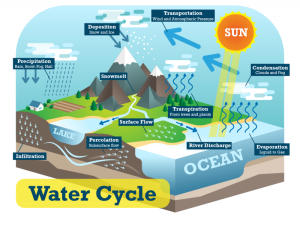Water Regeneration
The Water Cycle. “Water is essential to all being – humans, animals, plants, insects, fish. Water is constantly and naturally recycled through what we call the water cycle. There is never any new water on Earth. It’s all ways the same old water, recycled and cleaned all over again” (Canadian Space Agency, NASA).
Connecting Water Cycles and Watersheds
The water cycle refers to the continuous process by which water moves from the earth’s surface to the atmosphere and back again. There is never any new water; instead, water is recycled. Water moves through different parts of the environment in a cycle, constantly changing from one form to another (evaporation, transpiration, precipitation, and surface flow or runoff).

The water cycle and watersheds are closely related because the water cycle drives the water movement through a watershed. A watershed is an area of land that drains into a particular river or body of water. When water falls as precipitation, it can soak into the ground, evaporate into the atmosphere, or flow over the land and into streams and rivers. As the water moves through the watershed, it can pick up pollutants and nutrients from the land and carry them downstream.
Common pollutants in rain runoff include:
- Sediment and soil erosion: runoff from construction sites or areas with exposed soil can carry significant amounts of sediment and soil particles, which can harm aquatic ecosystems by blocking sunlight and reducing water clarity.
- Nutrients: fertilizers, manure, and other organic material can enter runoff and cause an overgrowth of algae and other aquatic plants, leading to low oxygen levels and harm to fish and other aquatic life.
- Bacteria and pathogens: animal waste, human waste, and other sources of bacteria and pathogens can contaminate runoff and cause illness in humans and animals.
- Chemicals: pesticides, herbicides, and other chemicals used in agriculture and urban areas can contaminate runoff and harm aquatic life, as well as pose a risk to human health.
- Heavy metals: pollutants such as lead, copper, and zinc can enter runoff from industrial areas or areas with old infrastructure and can harm aquatic life and pose a risk to human health if consumed (Deng, 2021).
Healthy watersheds are essential for maintaining the balance of the water cycle. When watersheds are intact, the land naturally cools and cleans the water that flows through them, helping to protect and enrich downstream water resources.
However, when the natural land in watersheds is colonized and damaged by activities such as deforestation, urbanization, or pollution, they can become less effective at regulating water movement and filtering out pollutants. The water cycle and watersheds are intimately connected, with the water cycle driving the movement of water through watersheds and watersheds playing a crucial role in maintaining the health of the water cycle.
Healthy watersheds are crucial for climate change mitigation and adaptation, as they are interconnected with aquatic ecosystems and can store carbon through natural vegetation and intact soil. By maintaining healthy watersheds, we can create resilient ecosystems that mitigate the impacts of climate change (EPA, 2021).
Reflect

Please use the following questions to guide your reflection:
- Think about your relationship with water daily. Journal about your relationship with water.
- Visit a river, lake, or shoreline in your community. Find the Indigenous place name. Reflect on the current name for that place and its previous Indigenous name. How did the location acquire these names? What are the differences between the two names? Is there any connection between them?


Feedback/Errata